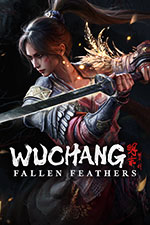Wuchang: Fallen Feathers Review
She’s Here to Ruffle a Few Feathers

Developer: Leenzee
Publisher: 505 Games
Genre: Action RPG
Release Date: July 23, 2025
Available on: PS5 / Xbox / Steam
Wuchang: Fallen Feathers begins sometime in ancient China. The land has become plagued with feathering, a disease that sprouts feathers on humans and essentially mutates them into a monster. A woman, Bai Wuchang, wakes up in a cave and she is infected by feathering but seems unaffected by it otherwise. So she sets out on a journey to discover more about this disease and perhaps cleanse the land.
Wuchang: Fallen Feathers is a soulslike (basically a kind of action RPG that typically features difficult boss battles and the risk of losing your accumulated XP when you are defeated) but at the same time isn’t like souls. The world design is very much like souls but the boss battles stray from the path with mixed results.
From the outset the game has some eye-catching visuals. This seems to be par for the course for many games made in Unreal Engine. Although, unlike other games that look like UE asset slop (Black Myth: Wukong), Wuchang looks like human hands touched every inch of the game. From robust bamboo forests, torn down buildings, wide open flower fields with petals fluttering in the wind, to whatever the world descends into later, the game remains gorgeous (or grotesquely gorgeous). Wuchang herself even gets a lot of detail, beads of sweat or water show up on her body, the viscera from defeated enemies accumulate on her, and the costumes are quite ornate. The game performance was mostly good for me. There were occasional stutters and there was some slowdown in the later areas but I didn’t encounter any crashes or game breaking bugs so I was overall satisfied with how the game ran.
The world of Wuchang, the ancient land of Shu (actual Shu) during the Ming dynasty, is a joy to explore and this is probably the best aspect of the game. It seems somewhat linear early on but paths branch out, shortcuts open up and there becomes a lot to explore. This can also be to the game’s detriment due to a lack of a map. You could (and I did) wind up missing important NPCs, items and paths tucked away. The game also doesn’t do the player any favors when they encounter specific doors which may sweep them to a different part of the map, which can also lead to more missed opportunities. But if you can remember where you’re going, where you’ve been and where you need to go then perhaps these won’t be issues for you.
From here things get a little sticker and your mileage may vary. The story somehow manages to be robust yet vague at the same time. There is a lot of dialogue in the game, more than a normal souls game in my opinion, but sometimes it is hard to follow. I think Wuchang herself could use a personality boost as well. She doesn’t get many dialogue opportunities, a few lines at the beginning of the game but goes silent after that. The reason Souls games (ones from Fromsoft) have a silent protagonist is because you create your character. But Wuchang is already an established character so she should have more engagement in the story than just selecting a dialogue choice and then starting into the distance. The other NPCs are great characters but Wuchang sadly can’t stand up to them.
The combat system has a lot of ideas. The idea of magic or special moves is tied to a system called skyborn might. You gain skyborn might by attacking or dodging attacks, some weapons accumulate it passively. This feels nice while actively battling but if you’re starting out a boss battle from zero it feels like a problem because you’ll go into a fight unable to use certain skills. The offset for this is using items that give you skyborn might but also increase your madness.
Madness is another system that seems like it could be improved. When your madness rises you inflict more damage but also take more damage. You also risk losing all your red mercury (souls / xp) and your doppelganger will attack you at certain points, defeating them will cure you of your madness. It doesn’t seem like a good tradeoff most of the time.
Weapons are limited in the game and so is the move set. You basically have one combo the whole game depending on your weapon. You have one heavy attack that is mainly only good for staggering enemies from behind. There were no heavy combos (at least with the longsword) and you also get one weapon skill (that uses skyborn might) and a discipline which could be a block / deflect or another type of skill. This is another tradeoff that doesn’t seem worth it most of the time, you will probably want to hang on to that deflect. You only find a few types of weapons in the game and in a long game like this more weapon variety would keep things fresh.
On the other side of the coin is the armor. There are a lot of different pieces of armor in the game. Things get complicated here too because there are very few pieces of “good” armor, that is to say armor with few downsides. Most of the armor pieces have tradeoffs, they are good against something but suffer greatly in another area, however, that weakness might be less on another piece of armor on the same set. It’s really too much to think about unless you feel like busting out a spreadsheet, so you’ll likely just stick to a few pieces that are the most balanced and occasionally change it for specific fights where you know you will need that resistance.
One other system is the idea of Temperance. This is a system where you can imbue your weapon with an attribute for a short time. While the game has a robust glossary, it is never explained how to use the Temperance. I thought it was something that worked passively (and it might be better if it did) but it’s something you need to equip and use as an item. This is probably the most important skill in the game and I didn’t realize how to use it probably until 80% through it.
Lastly these two things tie into each other. The experience system is almost like a sphere grid (from FFX) and the game gives you the illusion of freedom, to choose your path. There’s even a mechanic (quick draw) to switch between two weapons. However, you quickly realize that a second weapon is not viable at least until new game plus, otherwise your attacks will be too weak. This ties directly into the bosses which need to go back to the drawing board.
The bosses in the game start off seemingly somewhat balanced, they hit hard but you also hit hard and they have some special moves that make things challenging but the fight seems fair otherwise. Then the game hits a certain point where these bosses belong in a different game, at least with the offensive options at your disposal. Bosses suddenly are able to charge at you in the blink of an eye across a battlefield, they have endless attack strings, and even have projectile attacks that can hit you from across the battlefield as well. There are a bunch of magic spells in the game but many of them don’t seem beneficial in these battles, you will be a sitting duck.
So the boss battles become less of a battle of skill and more about memorizing attack strings. Can you figure out when to dodge, when to deflect attacks, find your opening to heal yourself (because attack strings are so long there are instances where the game gives you a window to heal), and also when to get some hits in on the boss while your temperance hopefully doesn’t run out? Unfortunately this is probably the worst part of Wuchang, and a big part of it. So you will have to be determined to make it though the game.
The game is also a bit of a moving target to criticize, it seems like every new patch significantly changes the game. As of 1.5 recovery speed from falling down has been sped up, elevators sped up, and healing is sped up. Supposedly (I haven’t’ seen it yet) the game has been “censored” regarding Chinese reviews that disliked how historical figures are portrayed in the game. All that being said the core of the game is the exploration and boss fights and those are things that I don’t think that can be changed significantly nor should they be. The developer should focus on refining their vision for the game instead of completely changing it. Big gameplay tweaks and substantial changes might be suitable for DLC or sequels down the line.
Overall I enjoyed my time with Wuchang: Fallen Feathers. My playtime was around 75 hours give or take for the first play-through. it does offer a new game plus option and four different endings which gives you reason to go back through the game again. Even with the gripes about the boss fights I would be willing to give the game another spin.





